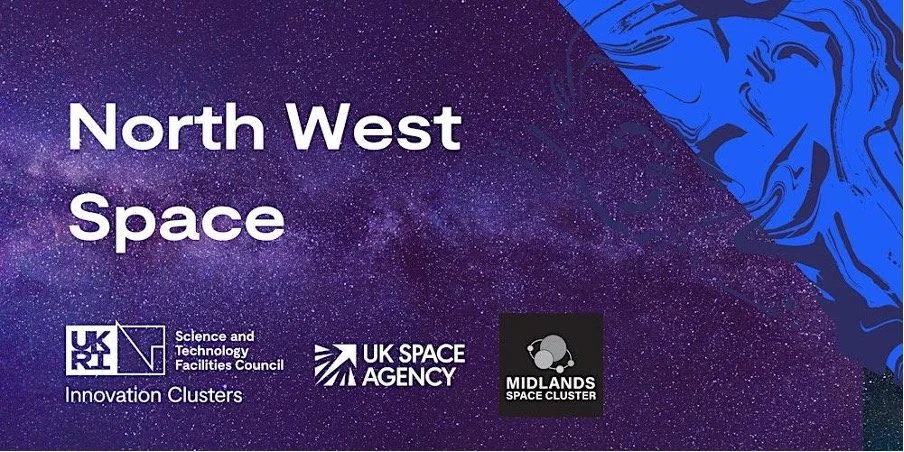The third North West Constellation of the year was held in conjunction with the Midlands Space Cluster at the Engine Rooms in Birchwood Park in Warrington on October 8th. Prior to the formal meeting there was a buffet lunch where ESR Technology displayed a part of the Hubble Space Telescope Solar Array drive mechanism that had been replaced by STS astronauts in 1993.
Alan Cross opened the meeting and welcomed all including some Midlands Space Cluster members. He gave an overview of STFC, it’s role in ‘discovering the secrets of the universe’ and developing advanced technology and the three NW Clusters viz Health, Digital and Space, based at Daresbury. Digital and Manufacturing are prioritised. NW Space Cluster projects included Power4Space with the Midlands Space Cluster, Local Space Partnerships, Resilient Communications with Space North and several other Cross Cluster projects including Beyond Earth and Autonomous Connected Earth. The UK Space Conference on 16th and 17th July next year is in Manchester for the second time in eight years.
Frank McQuade, Midlands Space Cluster Manager then described the region’s capability and plans. The Cluster covers the area from Wales to the East Coast with Stoke being the northern limit. The region houses many advanced manufacturing companies as well as eight universities with more than nine hundred researchers, the biggest number concentrated in and around Space Park Leicester.
As part of the UK’s interest in developing nuclear space batteries and microreactors Alan introduced Power4Space, a UK Space Agency funded ‘Pan Regional Partnership’ between the North West Space Cluster and the Midlands Space Cluster. The aim of this is to develop greater co-operation between the regions so as to maximise the benefit they, and the UK, receive from UK built Space nuclear systems.
Tim Tinsley, National Nuclear Laboratory, reminded everyone that nuclear power has been used in Space since the 1960’s from deep space missions such as Voyager to the Mars Science Laboratory. All the Mars rovers have used nuclear power. Plutonium 241 decays to Americium 241 and this is being developed in the UK as the power source for future Space missions. ESA has funded work for many years and he described the ongoing work between NNL and Leicester University. He also described the current NASA power requirements and some previous workshops.
Tim ended by inviting attendees to the forthcoming Power4Space workshops in in Space Park Leicester on 30th October and at Harwell on 31st October.
Then Colin Bridger from Amazon gave the first two minute pitch on AWS Space and Fusion and was followed by others including, Steve Wood Cumbria University, Andrew Millington ADM Projects, David Quill Flintloque Management Systems, George Titley Light Coatings, Malcolm Gresty DTI, Helen Jermak LJMU, Chris Wiles Hyde Aero Products, Paul Bhatia ESA Business Applications, James Miller PWHytek, Ray Stott Space Specialists, Bruce Poston Technia, David Robson Methera and Manchester student Ben Taylor.
Topics included Project Management skills and training, Engineering Design services, Management Systems, the Civil Aviation Authority and Space Regulations, the Defence and Security Accelerator, DTI, Radiation protection & analysis, the new Liverpool Robotic Telescope, Advanced Manufacturing, Structural Design and Test, Product Lifecycle Management, Actuators and Drives and MEO Satellite Constellations.
Simon Lewis and Olly Poyntz-Wright from ESR Technology then gave an overview and brief history of the company before describing current capabilities and projects. The European Space Tribology Laboratory (ESTL) was originally set up in Warrington in 1972 by ESRO, the forerunner of the European Space Agency (ESA). ESTL and it’s role of the testing of lubricants and mechanisms continues as part of ESR Technology. As well as providing safety and risk management consultancy the company now also designs, manufactures and supports a wide range of Space mechanisms and has worked on missions from LEO to GEO and beyond eg ESA’s cometry mission Rosetta and NASA’s Dragonfly mission to Titan. Current work included thermal shutters for Cubesats and on the Moon.
Amentum is the new name for Jacobs Space business and Sion Edwards described their heritage and current capabilities. Andrew Horner and James Dennis then described in more detail some of the projects and work undertaken. At Birchwood more than seven hundred engineers and scientists are involved in material characterisation, engineering and testing. Finally Sam White talked about their robotics development and simulation and it’s relevance to Space.
Summarising the event Alan Cross closed the meeting by advising everyone that the next Constellation event was another joint one, this time with Space Wales and would be at Airbus in Chester on 12th December. Finally he reminded all about the Sattucino events held at Harwell on the first Wednesday of the month and the fact that there is the opportunity for individuals to meet up and dial in from the Space Enterprise Laboratory in Daresbury.
Attendees then had the opportunity for further networking and touring ESR Technology’s facilities. For further information on the Space activity in our region contact bob.morris@thensc-uk.com

